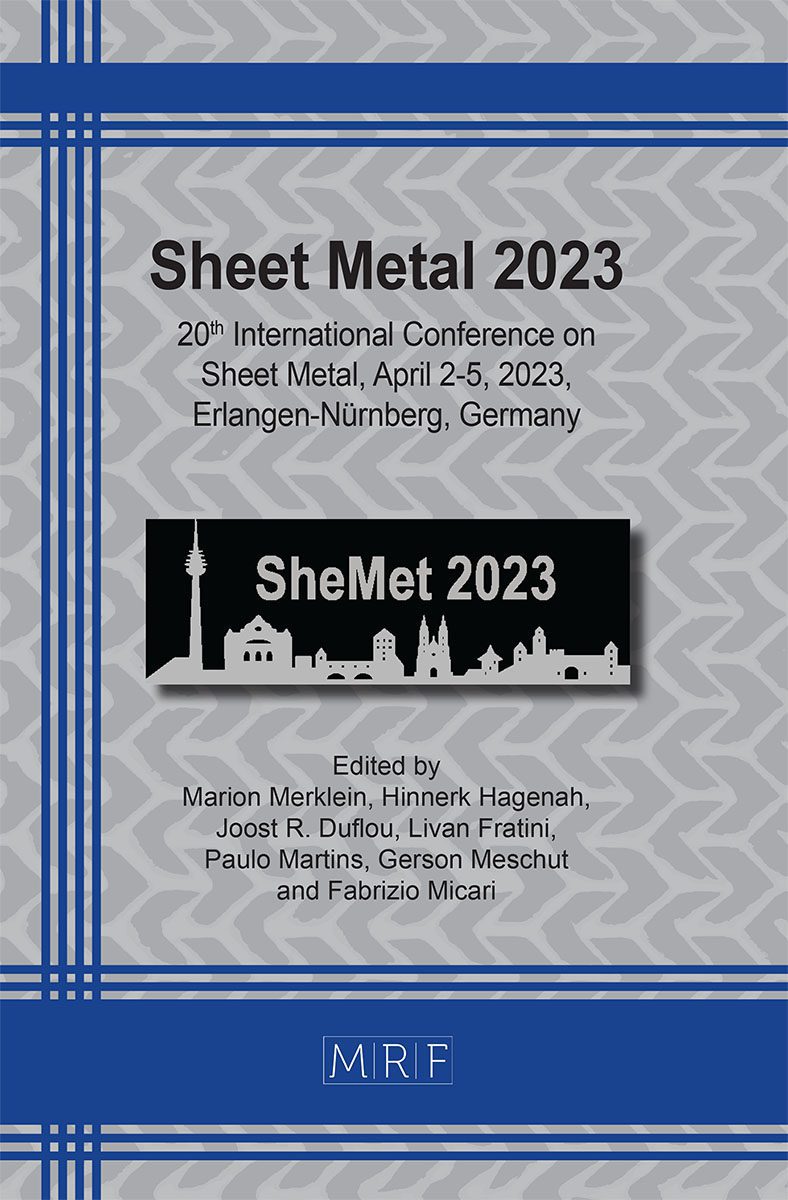Innovative mechanical joining processes in versatile process chains – potentials, applications and selection procedures
Michael Lechner, Fabian Kappe, David Römisch, Tim Rostek, Simon Wituschek
download PDFAbstract. Mechanical joining processes have gained extensive importance in recent years. In contrast to temperature-based processes, mechanical joining approaches allow the joining of dissimilar materials such as steel and aluminum. What most of the processes have in common is that they are often designed for a specific combination of materials and sheet thicknesses. Consequently, the versatility of these processes is limited. This article will therefore provide an overview of four innovative manufacturing processes, which allow a higher adaptability than conventional mechanical joining processes. In this context, the basic strategies, their applications as well as their advantages and limitations are presented. The contribution closes with a summarizing evaluation and an outlook.
Keywords
Joining, Material, Adaptive Manufacturing
Published online 3/17/2023, 8 pages
Copyright © 2023 by the author(s)
Published under license by Materials Research Forum LLC., Millersville PA, USA
Citation: Michael Lechner, Fabian Kappe, David Römisch, Tim Rostek, Simon Wituschek, Innovative mechanical joining processes in versatile process chains – potentials, applications and selection procedures, Materials Research Proceedings, Vol. 25, pp 101-108, 2023
DOI: https://doi.org/10.21741/9781644902417-13
The article was published as article 13 of the book Sheet Metal 2023
![]() Content from this work may be used under the terms of the Creative Commons Attribution 3.0 licence. Any further distribution of this work must maintain attribution to the author(s) and the title of the work, journal citation and DOI.
Content from this work may be used under the terms of the Creative Commons Attribution 3.0 licence. Any further distribution of this work must maintain attribution to the author(s) and the title of the work, journal citation and DOI.
References
[1] K. Martinsen, S.J. Hu, B.E. Carlson, Joining of dissimilar materials, CIRP Annals 64 (2) (2015) 679–699. https://doi.org/10.1016/j.cirp.2015.05.006
[2] D. Li, A. Chrysanthou, I. Patel, G. Williams, Self-piercing riveting-a review. Int J Adv Manuf Technol 92 (5-8) (2017) 1777–1824. https://doi.org/10.1007/s00170-017-0156-x
[3] K.-I. Mori, N. Bay, L. Fratini, F. Micari, A.E. Tekkaya, Joining by plastic deformation. CIRP Annals 62 (2) (2013) 673–694. https://doi.org/10.1016/j.cirp.2013.05.004
[4] Y. Abe, T. Kato, K. Mori, Self-piercing riveting of high tensile strength steel and aluminium alloy sheets using conventional rivet and die. JMPT 209 (8) (2009) 3914–3922. https://doi.org/10.1016/j.jmatprotec.2008.09.007
[5] P. Groche, S. Wohletz, M. Brenneis, C. Pabst, F. Resch, Joining by forming—A review on joint mechanisms, applications and future trends. JMPT 214 (10) (2014) 1972–1994. https://doi.org/10.1016/j.jmatprotec.2013.12.022
[6] G. Meschut, V. Janzen, T. Olfermann, Innovative and Highly Productive Joining Technologies for Multi-Material Lightweight Car Body Structures. JMEP 23 (5) (2014) 1515–1523. https://doi.org/10.1007/s11665-014-0962-3
[7] J. Varis, Economics of clinched joint compared to riveted joint and example of applying calculations to a volume product. JMPT 172 (1) (2006) 130–138. https://doi.org/10.1016/j.jmatprotec.2005.09.009
[8] D. Römisch, M. Kraus, M. Merklein, Experimental Study on Joining by Forming of HCT590X + Z and EN-AW 6014 Sheets Using Extruded Pin Structures. JMMP 5 (1) 2021. https://doi.org/10.3390/jmmp5010025
[9] D. Römisch, M. Kraus, M. Merklein, Investigation of Different Joining by Forming Stratgies when Connecting Different Metals without Auxiliary Elements. KEM 883 (2021) 19–26. https://doi.org/10.4028/www.scientific.net/KEM.883.19
[10] J. Popp, T. Kleffel, D. Römisch, T. Papke, M. Merklein, D. Drummer, Fiber Orientation Mechanism of Continuous Fiber Reinforced Thermoplastics Hybrid Parts Joined with Metallic Pins. Appl Compos Mater 28 (4) (2021) 951–972. https://doi.org/10.1007/s10443-021-09892-0
[11] C. Wischer, E. Wiens, W. Homberg, Joining with versatile joining elements formed by friction spinning. Journal of Advanced Joining Processes 3 (2021) 100060. https://doi.org/10.1016/j.jajp.2021.100060
[12] C. Wischer, W.Homberg, A contribution on versatile process chains: joining with adaptive joining elements, formed by friction spinning. Prod. Eng. Res. Devel. 16 (2-3) (2022) 79–88. https://doi.org/10.1007/s11740-021-01094-8
[13] DVS/EFB, Self-pierce Riveting – Overview: Sonderverfahren (2019).
[14] X. He, I. Pearson, K. Young, Self-pierce riveting for sheet materials: State of the art. Journal of Materials Processing Technology 199 (1-3) (2008) 27–36. https://doi.org/10.1016/j.jmatprotec.2007.10.071
[15] F. Kappe, M. Bobbert, G. Meschut, New Approach for Versatile Self Piercing Riveting: Joining System and Auxiliary Part. KEM 883 (2021) 3–10. https://doi.org/10.4028/www.scientific.net/KEM.883.3
[16] F. Kappe, C.-R. Bielak, V. Sartisson, M. Bobbert, G. Meschut, Influence of rivet length on joint formation on self-piercing riveting process considering further process parameters. ESAFORM (2021). https://doi.org/10.25518/esaform21.4277
[17] S. Wituschek, M.Lechner, Investigation of the influence of the tumbling angle on a tumbling self-piercing riveting process. Proceedings of the Institution of Mechanical Engineers, Part L: Journal of Materials: Design and Applications 236 (6) (2022) 1302–1309. https://doi.org/10.1177/14644207221080068
[18] S. Wituschek, F. Kappe, M. Lechner, Investigation of the influence of varying tumbling strategies on a tumbling self-piercing riveting process. Prod. Eng. Res. Devel. 16 (2(2022) 353–362. https://doi.org/10.1007/s11740-021-01099-3
[19] S. Wituschek, M. Lechner, Versatile tool design for a tumbling self-piercing riveting process. The 12th Tooling Conference & Exhibition, Tooling 2022, (2022) 499–506.































